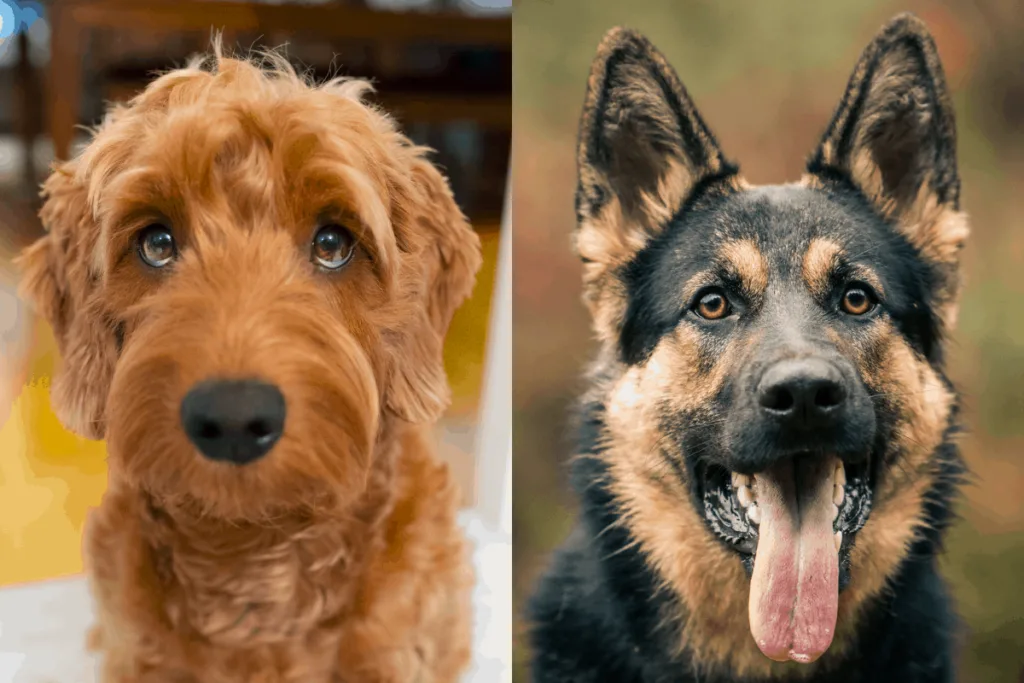
When it comes to choosing the right breed of dog for you and your family, you may end up with two final candidates. Deciding between these two breeds can be agonizingly challenging, but it doesn’t have to be. With the right information, you can make a more confident decision about which breed is right for you.
While these two breeds may seem very different by their appearance, German Shepherds and Goldendoodles share several distinct personality traits, such as loyalty and intelligence. Both of these breeds were developed to serve specific protection roles, and right one for you will come down to your personality and how much time you are able to devote to obedience training.
In this article, we’ll take a look at both German Shepherd and Goldendoodles to discover their defining characteristics, personality traits, and potential health problems.
We’ll also do our best to compare and contrast these two breeds, helping you choose the better one for you and your household.
Click Here to Jump to a Section
German Shepherd Profile
The German Shepherd is a relatively popular and well-known dog, especially in the United States.
Often raised to be protective and loyal dogs that guard their owners against harm, this breed (as you’ve likely guessed) originates from Germany.
And while they’re common household pups nowadays, this breed was once restricted to shepherding grazing livestock in the rural areas of Germany, hence its full name.
To truly understand this breed, you must start by taking a look at its history. Let’s take a quick trip back in time and discover just how this distinctive breed came to be!
History
Like all modern dogs, the German shepherd (Deutsche Schäferhund) is descended from ancient breeds that likely originated in Europe at least 15,000 years ago.
Rural farmers living in the German princedoms (later to become the German Empire under Prussian rule) trained and bred local dogs to assist in farming duties, mainly herding.
These pups would become the ancestors of the later, standardized German shepherd breed.
Each village had shepherding dogs that were unique to the community. As such, the original German shepherd came in many colors, sizes, and abilities.
Only the proto-breed’s shepherding temperament and instinct were common across all areas of the German princedoms. That is, until the late 1800s.
In 1889, a German man named Captain Max von Stephanitz decided to register and standardize the breed.
According to the German Shepherd Dog Club of America, Stephanitz saw a gorgeous shepherding dog while attending a dog show in Karlsruhe. He fell in love at once, bought the dog, and immediately began working to create a breed profile.
From this point forward, and with the help of the Verein für Deutsche Sch·ferhunde (a club dedicated to German shepherds, founded by Stephanitz), the German shepherd would slowly but surely entire to the consciousness of dog lovers around the world.
However, while the German shepherd was a beloved hound across Europe and throughout the United States for the first few years of the 20th century, two World Wars cast the breed into ill repute.
Germany wasn’t shy about using their newfound breed for military applications, and anti-German wartime sentiment led to a brief backlash against the breed.
Fortunately, animal rights are far more prevalent in Europe, the United Kingdom, and the United States. Blaming a canine species for the actions of man is illogical and immoral.
As such, the German shepherd is once again a prized and treasured breed.
Physical Characteristics
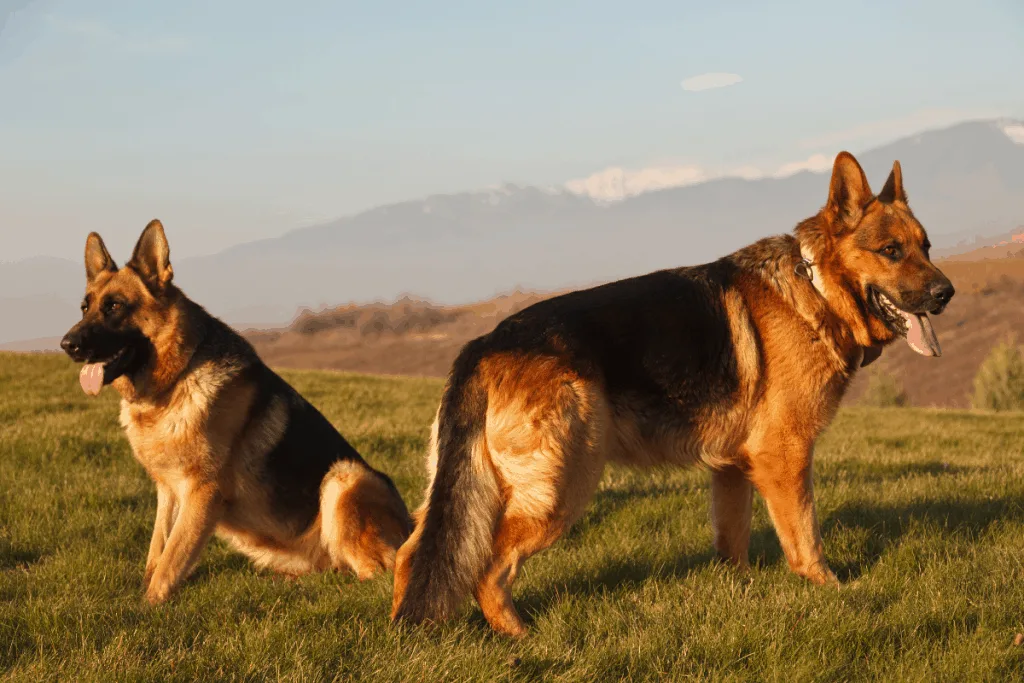
German Shepherds are equally defined by their body type as by their fur coloration.
German Shepherds are typically long, medium-height dogs with slender but well-muscled builds. They have dark eyes, proportionally long necks, and medium-length coats.
The coloration of a German shepherd is a mix of black, dark brown, and golden furs. The majority of breed-standard German shepherds have dark coloration around their eyes, mouths, ears, and backs.
This dark fur may often continue to the tail, darkening only the top portion. All other areas typically feature a golden or cream shade of fur.
German Shepherds stand approximately 24 inches tall and can weigh anywhere from 49 to 88 pounds, depending on the diet and sex of the particular dog.
In general, this breed is considered to be active, intelligent, and loyal. German Shepherds live between 9 and 13 years and may experience hip dysplasia, cataracts, and a handful of other inherited and common conditions.
The personality of a German Shepherd is bound to vary depending on its surroundings. When near family or loved ones, this breed tends to be fairly laid back. However, strangers can cause German shepherds to become defensive.
Still, they are not an overly aggressive breed and may only attack as a last defense against an intruder or attacker.
Personality
There are hundreds of unique dog breeds, and it’s essential to note that each breed represents dozens if not hundreds of years of consistent effort toward a specific goal.
Each breed is the product of human intervention, and the traits and characteristics common to each breed are things that were chosen by previous breeders and owners.
As such, it’s vital to consider the German Shepherd’s original purpose. As a shepherding dog, it’s primary job would have been to herd livestock animals across pastures or grazing land without allowing any to escape and wander free.
The earliest German shepherds also had to be passive enough to leave livestock unbitten and uneaten. These early traits can be witnessed in the modern German Shepherd breed.
German Shepherd puppies do require a lot of love, attention, and training, but they also tend to grow into intelligent, friendly, and loyal dogs.
Due to their protective nature and high intelligence, they could make an excellent addition to any family with children.
Naturally, it’s crucial to train your German Shepherd and be prepared to patiently repeat lessons involving safety.
It’s also imperative to ensure that your German Shepherd is getting plenty of exercise and mental stimulation. Otherwise, they may be tempted to take out their boredom and pent-up energy on toilet paper rolls, sofa couch cushions, and unsuspecting visitors.
Activity Level
German Shepherds typically have high activity levels. This can make their puppy years a bit frustrating, as they’ll exhibit periods of mania, chewing, and barking before collapsing into a ball for a quick nap.
This cycle tends to repeat until they’re well into adulthood, though with longer periods of sleep between times of play.
If you’re not prepared to spend plenty of time engaging with your German Shepherd, you may not want to adopt this breed.
While adult German Shepherds can be fantastically calm and friendly, especially around those they’re familiar with, puppies and young adults do tend to exhibit a higher energy level.
Additionally, adult German Shepherds require daily walks and plenty of room to walk and run around. They require hard toys to chew and plenty of mental stimulation as well.
Taking your German shepherd to a dog park to help them socialize and release energy is also a great idea.
A home with children may be better adapted at handling the high energy levels of the German Shepherd. Active children or homes with large backyard areas can be a treat for German shepherd pups.
Of course, owners will need to keep an eye out for common health problems, especially as their German Shepherd enters adulthood and old age.
Potential Health Problems
Because German shepherds are medium-to-large sized dogs, they can suffer from all of the illnesses typically associated with large breeds. These include but are not limited to:
- Canine Hip Dysplasia
- Degenerative Joint Disease
- Canine Elbow Dysplasia
- Bloat
- Cataracts
However, German Shepherds can also suffer from a few unique health issues, such as epilepsy and hemophilia.
Diabetes is also a common problem for this breed. However, that has more to do with feeding habits than genetics.
Unfortunately, there’s not much that owners can do to help slow the wear and tear of their dog’s joints and cartilage. Nor is there’s much help for German shepherds with age-related cataracts.
Due to this breed’s size, it doesn’t tend to live far past ten years of age.
Additionally, the weight of this breed’s muscular body produces an arthritis effect over time. This means that highly active German shepherds can enjoy a higher quality of life during their youth, but suffer severe health problems in their old age.
Waterborne activities may help your German Shepherd enjoy the exercise it craves without putting so much strain on bones and joints.
It’s also crucial to feed your German shepherd the right blend of proteins, fats, vitamins, and minerals. Otherwise, they may become overweight or develop diabetes.
Feeding Recommendations
When it comes to feeding your German Shepherd, you must choose high-quality ingredients and serve moderate portions.
It can be only too easy to pick up a bag of cheap store-bought food and pour a massive bowl for your pup, especially if you work long hours.
However, a carb-heavy, fat-rich kibble diet is only bound to harm your German Shepherd, not nourish it.
If possible, purchase raw meats and fish to feed to your dog. Using a food processor, finely dice your chosen protein alongside nutrient-rich dog-friendly vegetables.
Green beans, spinach, carrots, and sweet potatoes are only a few of the potential veggies you could choose. You don’t necessarily need to go out of your way to feed your dog healthy meals.
If you see that you have a few vegetables in your fridge that are just about to go bad, you can use them for your German Shepherd’s dinner.
Naturally, you’ll want to avoid using ingredients that show actual signs of rot or decay. Otherwise, you could make your pup ill.
Feeding your German Shepherd a high-protein diet without fillers or huge portions of salt and fat is part of your duty as an owner. It’s also a vital part of their overall care.
For the best article available on the internet (no joke!) on properly feeding your German Shepherd, take a look at this excellent article:
German Shepherd Feeding Guide: All You Need to Know
Care and Training
German shepherd care is relatively straightforward. Most German Shepherds benefit from daily brushing with a stiff-bristled brush that helps them to naturally shed old hairs.
A steel or aluminum grooming brush for more effective brushing can be helpful, but it should only be used a few times each week.
This brush by Furminator is a popular choice and does the job perfectly.
This breed requires near-constant stimulation, especially during its youth. Owners will need to provide plenty of activities, toys, and treats to keep their German shepherd happy and interested.
Because this is such an active breed, multiple walks per day are a requirement.
German Shepherds can also benefit from weekly oral hygiene rituals like tooth brushing, and their nails may be trimmed to help prevent them from growing too long and damaging the paw.
Due to their multiple coats, German shepherds only need to be bathed every four to five months.
It’s easier to train German Shepherd if you start the training process at a young age.
However, this breed is known for its intelligence and can be trained relatively quickly and easily, especially by owners with previous experience in dog training techniques.
For more on German Shepherd training, be sure to check out this comprehensive and easy to follow article linked below:
German Shepherd Training Guide: All You Need to Know
Goldendoodle Profile
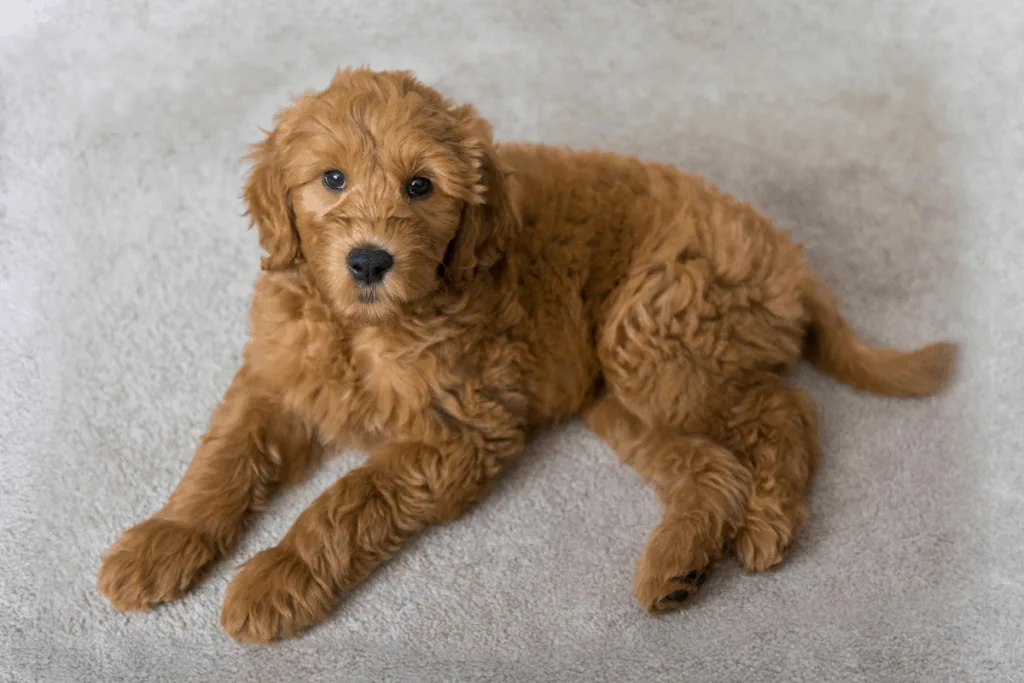
The Goldendoodle doesn’t enjoy the same long history of the German Shepherd. That’s because Goldendoodle dogs are relatively novel designer hybrids of Golden Retrievers and Poodles.
As such, the physical characteristics, personality, and potential health problems of a Goldendoodle aren’t set in stone.
However, by studying the two parent breeds that make the Goldendoodle, we can develop a deeper understanding of this new hybridized breed.
Let’s begin by exploring the history of the Golden Retriever and Poodle breeds!
History
Understanding the full history of the Goldendoodle requires a little patience. After all, you must consider the two distinct parent breeds before attempting to examine the resulting offspring.
As such, let’s first discuss Golden Retrievers and their rise to prominence among the many registered canine breeds.
Golden Retrievers
Golden Retrievers are, for all intents and purposes, Scottish dogs. Their earliest beginnings can be traced to the northern areas of the British Isles, though England’s southern coastal areas certainly played a part.
As with German Shepherds, the emergence of the Golden Retriever can be traced to a singular individual.
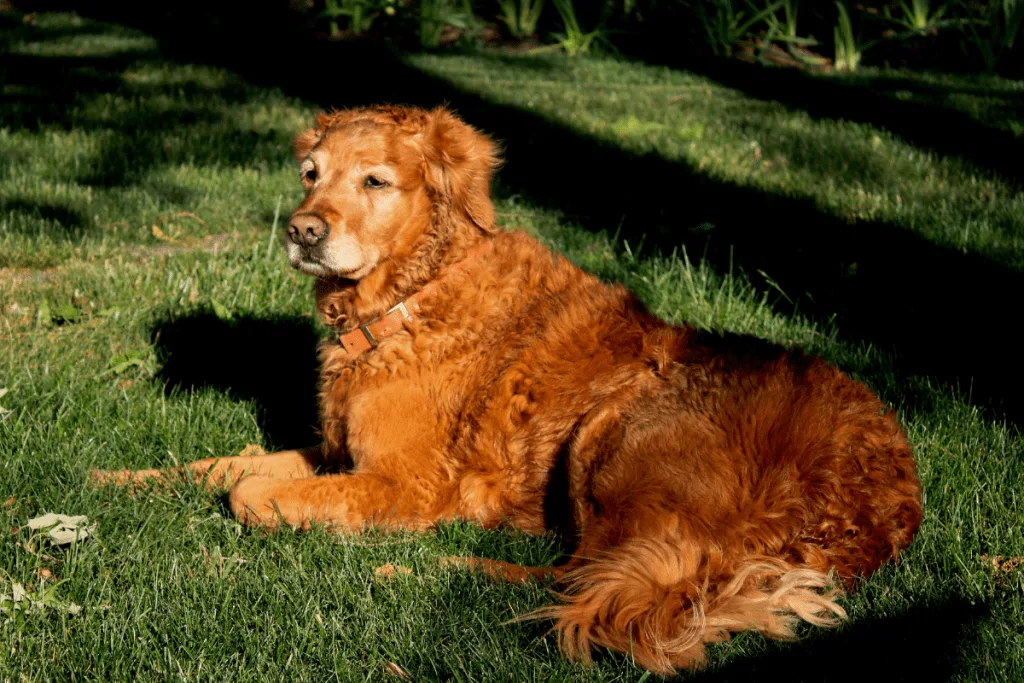
This time, it was a Scotsman by the name of Dudley Coutts Marjoribanks that ensured the existence and exultation of a new dog breed.
The story goes that in 1865, Marjoribanks was in Brighton with his son, most likely walking around the sandy shoreline near the place that would eventually become the Brighton Palace Pier.
While out on their stroll, they spotted a uniquely golden-colored pup out and about with his owner.
Within a few years, Marjoribanks would purchase that dog and bring it home to the Scottish Highlands for breeding. After crossing this pup with a Tweed Water Spaniel, he had his desired mix.
As such, in 1868, the first litter of Golden Retrievers was born. For the first several years of their existence, they were not bred and sold so much as carefully gifted.
This association with power, elite status, and rare good luck would help propel the breed into public consciousness and may have helped to make it one of the most popular breeds in North America.
Poodles
Poodles are often associated with France and French culture. However, they’re believed to have originated in Germany.
Poodles are one of the oldest dog breeds, and examples of their existence can be traced back to the 1400s.
Their name comes from a German expression that loosely translates to “puddle,” signifying that the breed was fond of water.
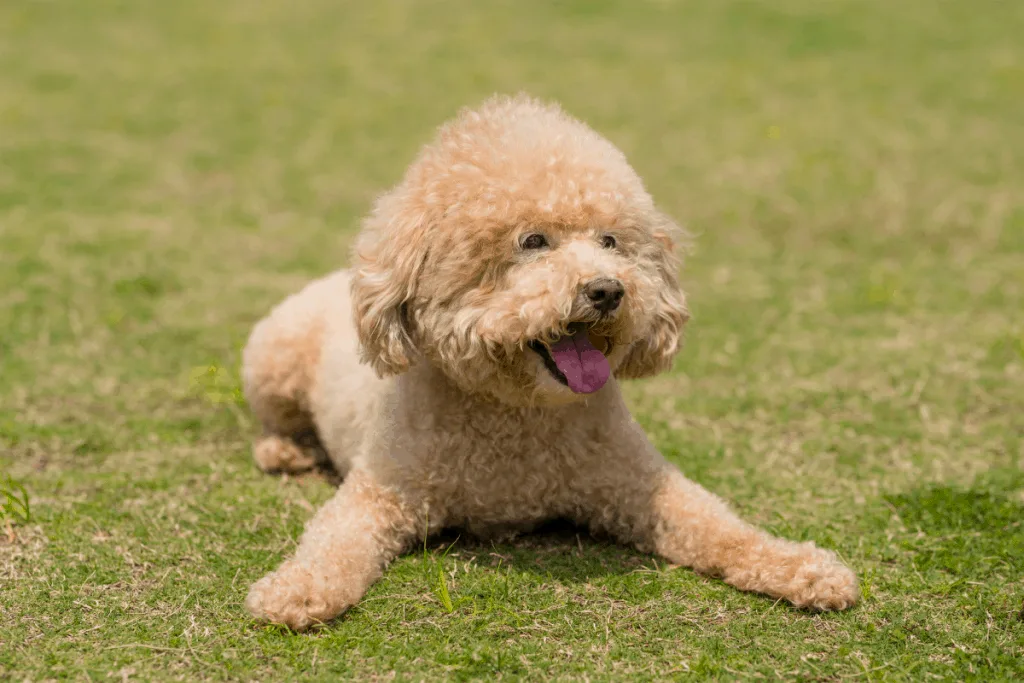
The earliest Poodles were solely bred for hunting, particularly waterfowl hunting. This means that proto-Poodles hunted ducks, geese, and any other type of waterborne bird they could chase down.
The owners of these early Poodles could have had no idea how popular the breed would become.
Like the Golden Retriever, well-groomed and opulent-looking poodles would soon become the territory of the upper classes.
Only the most affluent and wealthy members of society owned Poodles, and their popularity among the royalty of Spain, France, and many European houses was well-known.
Goldendoodles
Goldendoodles are dogs that have a Golden Retriever and Poodle parents. They can exhibit characteristics from both breeds, but each pup tends to be slightly unique. That’s because this designer hybrid has yet to become a fully-fledged breed.
Still, most Goldendoodles have the light gold or rich golden-brown coloration of a Golden Retriever, but tons of gentle curls like a Poodle.
Their size often varies and may be most dependent on the size of their Poodle parent, as Poodles come in three standard sizes.
In many ways, Goldendoodles are said to resemble gigantic brown teddy bears. However, their precise temperament and physical character differ from pup to pup, and it’s vital to consider both parent breeds when attempting to understand the resulting offspring.
Physical Characteristics
The exact physical characteristics of a Goldendoodle depends on the physical characteristics of its parents.
Offspring born of a large Golden Retriever and a standard-sized Poodle are likely to be large dogs. However, offspring born of a medium-sized retriever and a Miniature or Toy Poodle can be small or medium-sized.
Still, the majority of Goldendoodles tend to exhibit a similar coat and coloration. Goldendoodles, as their name suggests, should be a light yellow, golden, or golden-brown color. Unlike their Golden Retriever parents, this fur should be curly.
This golden fur may grow in tight curls that never seem to get very long, or it might grow in loose waves that need consistent trimming.
To achieve the optimal Goldendoodle pup, breeders and buyers should choose parents that exhibit the desired traits of the offspring.
For example, breeders looking to produce pups with thick, curly hair that is very light in coloration may want to breed a particularly wavy-haired, light-colored Golden Retriever with a curly-haired, light-colored Poodle.
Still, due to their highly variable size, it’s tricky to name a precise weight or height for the Goldendoodle.
However, their personality and temperament may be slightly more predictable.
Personality
As with nearly all aspects of the Goldendoodle, it’s crucial to examine the traits and abilities of the parent breeds to discover more about the resulting Goldendoodle pups.
Consequently, we must take the personality of the Golden Retriever and the Poodle into equal consideration.
Golden Retriever
Golden Retrievers are beloved for their kind disposition, loyal attitude, and generally laid-back approach to life. They make excellent family dogs, especially for families with fairly active lifestyles.
Golden Retrievers left to sit and lounge around all day are likely to become overweight and suffer greater mobility issues, especially later on in life.
But due to their interested, intelligent nature, they’re the perfect companion for nearly any outing.
Poodle
Poodles can be slightly more energetic and active than Golden Retrievers. Their slim body shape allows them to run and trot rather quickly, and they get excellent exercises when allowed to play in large, open spaces.
Poodles are quite intelligent, but they can also be more aloof and standoffish than Golden Retrievers.
In general, Poodles have a very proud and self-sufficient personality. When they begin relying on a particular person’s affection, food, or attention, the Poodle may finally begin to show a bit of loyalty.
Still, Poodles are a relatively independent breed.
Goldendoodles
Goldendoodles exhibit many of the traits of their parents. They’re often very intelligent, active, kind, and loyal.
One of the traits not often passed down to progeny is the Poodle sense of pride. Of course, this may be partially due to buyers not desiring this particular trait in their Goldendoodles.
Because this breed is an unregistered hybridization of the Golden Retriever and Poodle breeds, the exact personality and temperament of Goldendoodle can vary.
Activity Level
As mentioned above, both the Golden Retriever and Poodle are active breeds. However, the Poodle can be more energetic than the Golden Retriever. As such, their offspring are likely to be reasonably active.
Individuals hoping for a slightly more laid-back puppy may need to breed a larger, less rambunctious Golden Retriever with a notably laid-back Poodle.
Of course, results are bound to vary as this designer breed continues to come into their own.
Potential Health Problems
Golden Retrievers are medium-sized or large-sized dogs. They tend to suffer from many of the conditions the German Shepherd develops, especially in old age.
Their life expectancy is about 10 years.
Poodles come in three standard sizes, but larger breeds often experience hip dysplasia and joint problems. These heftier Poodles also tend to live for about 10 years.
Smaller Poodles or medium-sized Golden Retrievers may offset many of the conditions their larger counterparts encounter, thus living for 13 to 18 years in total.
As such, the lifespan and potential health problems of the Goldendoodle are entirely dependent on its size.
Naturally, any genetic conditions that could be inherited by its parents should also be taken into consideration. Sebaceous adenitis, a skin condition, is one such hereditary risk to keep an eye out for.
Goldendoodles may also suffer from Addison’s disease, cataracts, and heart conditions.
Before adopting a Goldendoodle, it may be wise to have their health cleared by a third-part veterinarian. Doing so could help you avoid emotionally-gut wrenching veterinary visits in the future.
Feeding Recommendations
The best diet for Goldendoodles is one that is nearly identical to the one for German shepherds.
Goldendoodles may be prone to allergies, so their consumption of grain products should be severely limited. Instead, they should be given fresh sources of protein in the form of meat, fish, or poultry.
They should also be fed healthy fruits and vegetables to help them receive the micronutrients they need to stay healthy. Fish, spinach, and carrots could be a fantastically simple but effective meal for a Goldendoodle.
The abundance of omega-3 fatty acids, heart-healthy vitamins and minerals, and eye-maintaining lutein is bound to help a Goldendoodle prevent many of the common ailments of their kind.
Care and Training
Both the Golden Retriever and the Poodle are smart, highly-intelligent dogs. As such, their offspring, the Goldendoodle, is most likely going to need tons of mental stimulation to stay happy and obedient.
Fortunately, the flip side of this requirement is faster, more effective training.
If you plan on getting a Goldendoodle, you should also plan on getting plenty of dog toys and investing time in training your pup.
It may also be a good idea to familiarize yourself with local dog parks or walking routes, and large Goldendoodles are liable to require more physical stimulation and activity as well.
Due to their curly coats, some of which may be relatively long, Goldendoodles need to be brushed at least every other day with a stiff-bristled brush.
Straight, metal-bristle brushes can pull on the delicate curls of a Goldendoodle, so pet parents need to invest in the right brushes and utilize pain-free brushing techniques.
In terms of bathing, you could bathe a Goldendoodle up to once per month, though it’s important to not over-bathe them. This could cause their skin to become dry and brittle and may even contribute to painful skin conditions.
And unlike Poodles, Goldendoodles don’t appreciate being shaved.
Which Is Right for You?
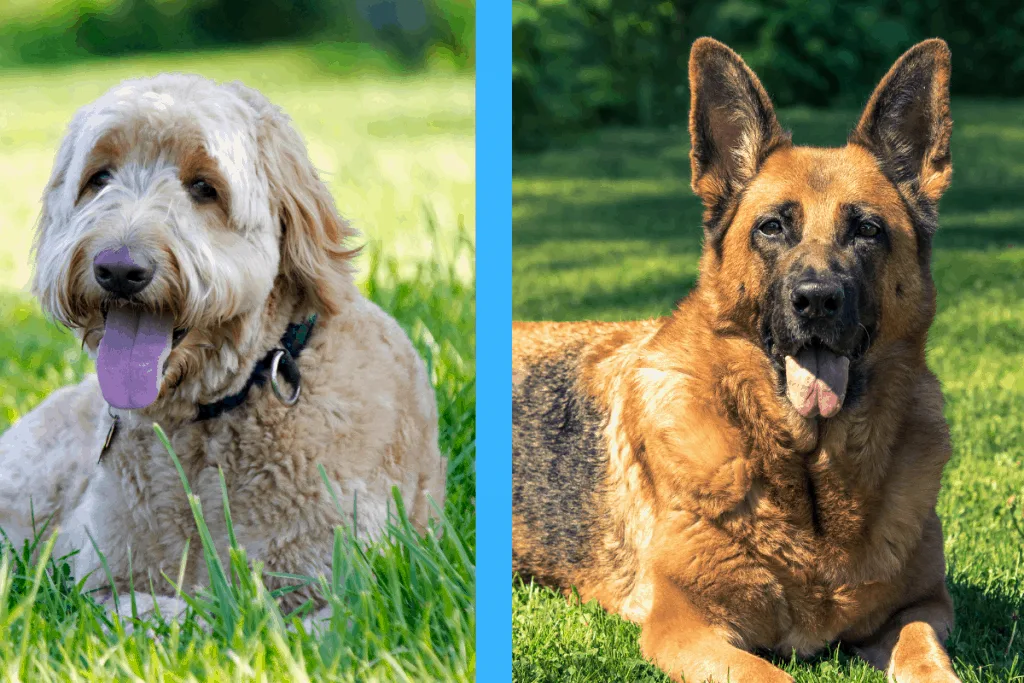
Choosing between the German Shepherd and the Goldendoodle can be tricky. Both breeds have unique personalities, physical features, and temperaments.
In the end, the best breed for you and your household depends on your preferences.
Both the German Shepherd and Goldendoodle are fairly high-maintenance, loyal breeds.
The primary differences between them are potential activity levels and availability. German Shepherds may be more excitable and action-oriented than Goldendoodles.
Additionally, it may be a challenge to find Goldendoodles, as they’re a relatively recent hybrid that is often available in small numbers.
German Shepherds, on the other hand, are far more plentiful. However, the look and temperament of the Goldendoodle make it a unique and desirable designer dog.
As such, you’ll need to answer the following questions before choosing one of these two dogs. You’ll need to ask:
- How much time do I have to play with my dog and ensure it gets plenty of exercise?
- How much time do I have to groom my dog and ensure that their hair/fur is properly brushed?
- How much time do I have to be affectionate with my dog and help them feel loved and comfortable?
- How willing am I to deal with serious health conditions associated with large-sized dogs?
By answering these questions, you can get a little closer to making your final decision.
In the right home, either of these breeds would be a dream come true and a real addition to the family. However, both breeds require fairly consistent grooming, watchful feeding, and tons of exercise.
Final Thoughts
German Shepherds originate from Germany and are beloved for their protective nature and intelligent personality.
Goldendoodles are a designer breed created by breeding Golden Retrievers and Poodles together. Their characteristics can vary depending on the exact sizes and temperaments of their parents.
The right breed for you depends on your preferences and lifestyle habits.
Both breeds will require consistent grooming and exercise, but German Shepherds may be slightly larger and more active than Goldendoodles.
Still, much of the final decision comes down to preferences.
German Shepherds have medium-length dark and cream-colored fur while Goldendoodles have golden-brown curls.
German Shepherds are almost always medium or large dogs, while Goldendoodles come in many sizes.
If lifestyle is not an issue, you’ll need to use your aesthetic preferences to make a final decision.

